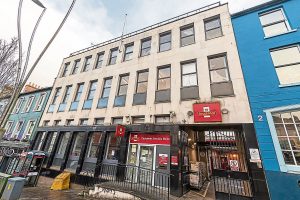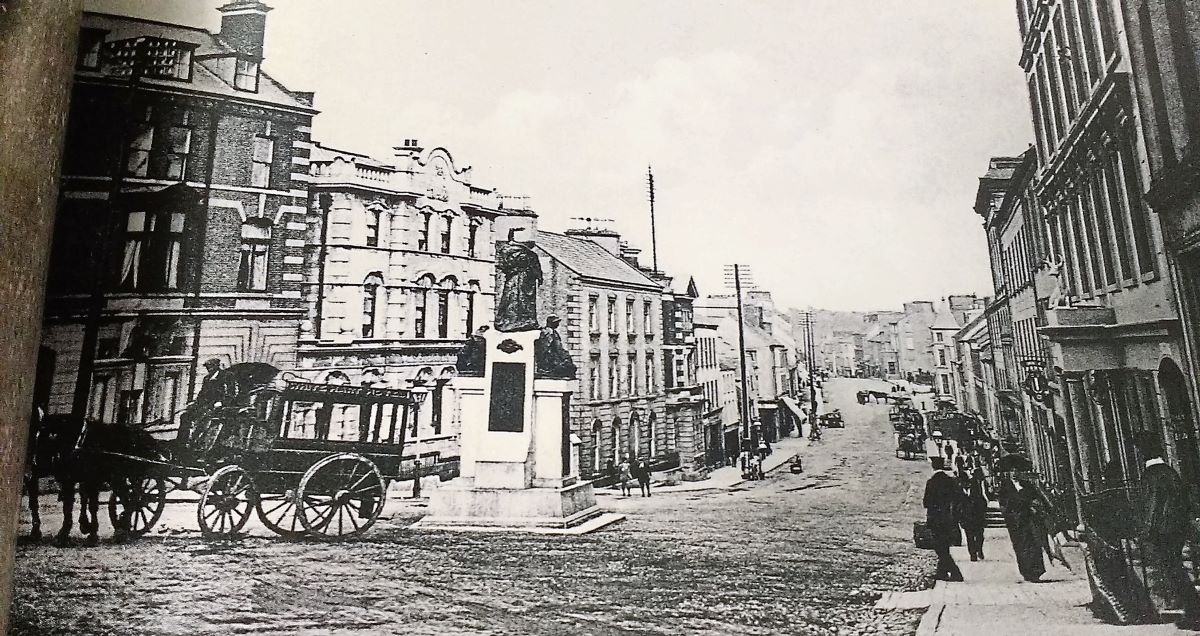In the heart of Omagh, nestled at the top of High Street, once stood the White Hart Hotel, where the Royal Mail building now resides on the corner with John Street.
With a history dating back to the early 19th century, this distinguished establishment evolved from a bustling hotel to a hub for Freemasons and, later, the headquarters of the Special Constabulary post-partition.
The date of the building’s consecration is unknown, but the first recorded proprietor was a man named David Greer Esq.
Mr Greer and his wife, Elizabeth, were well-respected people in the town. However, tragedy struck the family when David died in 1839, aged just 52.
His wife, Elizabeth, held onto the building until 1861, when local man, William Mullin, bought the premises with the grand vision of a town hotel.
Mullin’s 40-year reign marked a period of significant development for the ‘White Hart’. Boasting four stories, the hotel featured 31 bedrooms, private drawing, dining, and sitting rooms, along with offices, servants’ quarters, a large dining room, and a commercial room. The front door bore a mythical white stag; a defining feature alluding to the hotel’s name.

Guests enjoyed access to coffee rooms, a bar and a billiards room.
Mullin also established a ‘posting department’, which was supplied with cars, carriages and drivers.
This allowed for transportation between the hotel and the train station for guests coming from beyond the county borders, with arrangements to attend the ‘arrival and departure of every train’, according to a Freeman’s Journal article in 1861.
The White Hart Hotel played a central role in the community, hosting a variety of events and gatherings. Notably, it became the meeting place for three Freemasonry lodges on a near-permanent basis.
The Freemasons, having outgrown their previous meeting space at a small house in Campsie, found a new home within the halls of the White Hart.
In 1872, they moved to a large room near the rear of the hotel, celebrating this transition with a consecration ceremony, complete with corn oil and wine.
meetings
In the 1880s the so-called ‘Uncrowned King of Ireland’, Charles Stewart Parnell, stayed at the hotel while conducting a series of political rallies in Omagh and surrounding villages.
Over the years, the White Hart witnessed numerous important meetings and events, including the Omagh Farming Society Ploughing match in February 1871.
Judged by Mungo Sloan, Charles Pollock and James Johnston, the first place came to Dervaghroy man James Roulston with his son holding the plough.
A separate category of the ‘Gentlemen’s class’ was won by James Greer Jr Esq, in a nod to the family name held by the previous owners of the hotel.
Following the awards, the society dined together in the hall of the hotel.
In June of 1896, the hotel hosted a group of archeologists as they toured Tyrone to document its ‘mythological artefacts’.
Approximately 90 individuals, accompanied by local experts, gathered at the hotel to embark on an excursion which covered locations such as Knockmany, Augher, Clogher, and back to Omagh, with the White Hart providing refreshments for their journey.
Later, in 1903, the Irish Medical Association chose the White Hart to be their choice of venue to discuss the formation of a Tyrone branch of the medical group.
Appointed as president of this branch was Dr Edward Charles Thompson, who worked as a doctor within the infirmary of the Omagh Workhouse.
The early 1900s ushered in a new era for the White Hart Hotel after 44 years under the Mullin family. The last owner in this lineage was town solicitor, Charles Mullin.
In a testament to the respect held for Charles, a public fundraiser was organised to erect a fountain and lamp in front of the hotel in his memory.
Following Charles’ passing, the hotel and its contents were auctioned off in January 1905, including cars and carriages.
The hotel was brought under new management in 1907 by a Mr and Mrs Baker, who now added a garage, stockroom and stables, also advertising themselves in the UH as ‘the only licenced hotel in Omagh’.
The Bakers were the last to run the White Hart as a hotel, and, by the 1920s, the site found a new purpose as the Post Office Savings Bank.
Interestingly, this branch of the savings bank occupied only a small portion of the original hotel, and the remaining space was repurposed.
The new inhabitants would occupy the space once used by the public, and an intriguing chapter in the building’s history unfolded in 1926 when the Special Constabulary of the Royal Ulster Constabulary (RUC) established their headquarters there.
The building underwent yet another transformation in 1962, when Royal Mail fully acquired it.
This branch served Omagh’s postal and licensing needs up until the early 2000s, when SuperValu on Market Street opened its post office, prompting the closure of the High Street site.
However, the building was not destined to remain dormant. In 2015, it was reopened by Royal Mail, albeit with reduced functionality.
The revived site focused on sorting drop-in parcels, collections, and deliveries. This old building remains a tangible link to Omagh’s distant past, and the White Hart, just like Knock-Na-Moe and The Royal Arms, will be fondly remembered as an iconic name in the town’s history of signature hotels.







